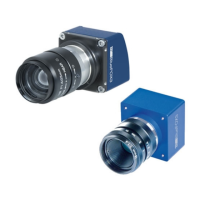7.3.5.2 For Odroid-U2 / -U3 Users
Although Odroid-U2 and Odroid-U3 do not have a USB 3.0 port, you can use the mvBlueFOX3
cameras with the USB 2.0. Jusst adapt the following settings:
Locate the file boot.scr (by default: /media/boot).1.
Export the strings from the file:
strings boot.scr >> boot.txt
2.
Add or adapt the string "usbcore.usbfs_memory_mb=256" at the end of the boot arguments
using a blank:
setenv bootargs "... usbcore.usbfs_memory_mb=256"
3.
Create a new boot.scr from the modified boot.txt.
mkimage -A arm -T script -C none -n "boot.scr for ODROID" -d boot.txt boot.scr
4.
Reboot the board.5.
Note:
The net bandwidth of USB 2.0 remains the same of course (30 MB/s).
7.3.5.3 For Raspberry Pi Users
Like Odroid-U2 and Odroid-U3, the Raspberry Pi only features a USB 2.0 port. However, it is also
possible to use the mvBlueFOX3 with this port, just follow these steps:
Open the file /boot/firmware/cmdline.txt as root.1.
Add or adapt the string "usbcore.usbfs_memory_mb=256" at the end of the boot arguments
using a blank:
setenv bootargs "... usbcore.usbfs_memory_mb=256"
2.
Save the file.3.
Reboot the Raspberry Pi board.4.
Note:
Likewise, the net bandwidth of USB 2.0 remains the same of course (30 MB/s).
7.3.5.4 For NVIDIA Tegra TK1 Users
To use the camera following adaptions are necessary in the standard configuration of the NVIDIA
Tegra TK1 board:
Update the software to version 21.3. Please follow this descripion.1.
Afterwards, you have to adapt the boot parameters in /boot/extlinux/extlinux.conf:
Change "usb_port_owner_info=0" to "usb_port_owner_info=2" (this will change the
USB port behavior from USB 2.0 to USB 3.0).
1.
Set "usbcore.autosuspend=-1" (power save mode is off now).2.
Set "usbcore.usbfs_memory_mb=256" (this will increase the buffer of the USB bus)3.
2.
Install the mvGenTL_Acquire driver.3.
Now, the camera should work. If you could not find the mvBlueFOX3 driver, you would add the
current user to the plugdev group:
sudo usermod -a -G plugdev ubuntu
7 Quickstart
44

